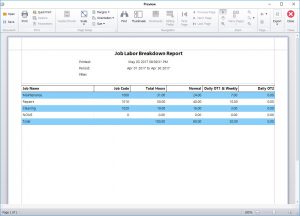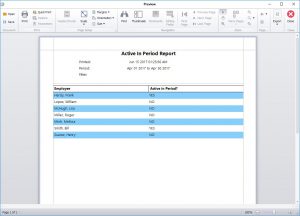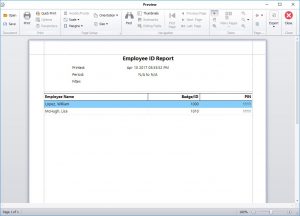by Mark Nemtsas | Oct 21, 2017 | News
The recent move of this web site to a secure server requires all users of the Email Alert system to update their Time Clock MTS Web Extensions installation to the latest version. The upgrade installer can be downloaded here:
Download Web Extensions Upgrade Installer
You’ll have to download and install the update on any computer that is using email alerts.
by Mark Nemtsas | Aug 4, 2017 | New Releases, News
It’s been a rough few weeks here for us due to a number of technical issues. The complete failure of our Windows 7 build machine kicked it all off. We decided to move to Windows 10 for our build process and that took a bit longer than expected. Throw in some issues that Windows 10 caused, a fairly significant problem with the installer for Time Clock MTS version 6.1.1 that raised issues with a number of users, a false positive virus scan on the program installation file, an obscure Windows XP bug, and dealing with time clock computers with broken Windows Fonts and you’ve got a set of circumstances that have tried us. Never the less, we’re sure we’ve seen all of that off and as a result we’ve come out the other side with a better, more reliable product. Two releases have happened in the last two weeks, versions 6.1.2 and 6.1.3. The changes should be invisible for most people, but I’ll detail them anyway.
Windows Font Issues
There were at least two users who (somehow) didn’t have the regular version of the Times New Roman font installed on their computer. The reporting system of Time Clock MTS is dependent on this being present, and given that it’s a default Windows font you can (usually) rely on it being present. The software was failing silently if the font was missing. This error is now caught and presented to the user. Fixing the missing font is as simple as finding the valid times.ttf file on another computer, copying it to the broken computer, and installing it.
Client First Run Issues
The first run process for the Time Clock MTS Client software was broken. It would allow users to connect to a shared time clock data file but reports could not be run and employees not punched in or out immediately after connecting to the data file. Restarting the software fixed the problem. Clearly this was not satisfactory and has now been resolved.
Windows XP “Multiple Steps” Error
One Windows XP user was getting a “Multiple-step OLE DB operation generated errors” error message whenever they started their software. According to this Microsoft Knowledge Base Article it’s due to a malformed or missing Windows registry entry. We followed one of the suggested resolutions in the article which was just a tiny change to the software, and the problem was resolved.
Referenced Backward Compatible ADO Library
Moving to a Windows 10 build process lead to us adopting the latest version of the Microsoft Active Data Objects library which is used for all of the database systems in Time Clock MTS. It turns out that this library is not compatible with Windows versions prior to Windows 7 Service Pack 1. As we are committed to supporting old versions of Windows for as long as possible we’ve now started using a backwards compatible version of the Active Data Objects library and the software now runs properly on Windows Vista and Windows XP. It’ll also work on Window 7 if you don’t have Service Pack 1 installed, but to be honest, if you’re using Windows 7 without Service Pack 1 you should strongly consider installing it.
Version 6.1.1 Installer Issuers
Version 6.1.1 included a brand new component that moved some old forms into a .NET library. This was part of our on-going future proofing development program for Time Clock MTS. Unfortunately we messed up how this component was included in the installer and as a result some users were getting strange application crashes and “file not found” errors. We’ve reviewed the installation processes now and identified where we went wrong and fixed up those issues.
False Positive from Mcafee Antivirus
We had one report of the installer being identified as containing a virus by a user with Mcafee anti-virus on an Acer laptop. Obviously this was a false positive. We were unable to replicate the false positive with our install of Mcafee. We made some adjustments to the software build process and had the user re-test the new installer and it no longer is identified as containing a virus.
by Mark Nemtsas | Jun 30, 2017 | New Features, News
The release of version 6.1.1 of Time Clock MTS included a couple of brand new reports. One is aimed at users of the job tracking system, the other useful for working out what employees have (and have not) worked during a given time period.
Job Labor Breakdown Report
If your business tracks time employees spend on jobs, whether that be because you charge your customers to perform those jobs, or because you simply like to know what your employees are working on then the cost of labor is a key piece of information you need to know. The new Job Labor Breakdown Report produces a single table of information showing the time worked on each active job in in Time Clock MTS. The report further breaks the time down into normal hours, OT1 hours and OT2 hours. You can see an example of the report below.

The Job Labor Breakdown Report
This information was certainly available previously in Time Clock MTS, albeit in a much more verbose fashion via the Job Cost Report. However, we’re sure you’ll agree that the new Job Labor Breakdown Report gives a more concise summary of your real job labor costs.
Active in Period Report
It can be useful as an employer to be able to quickly determine who has (or has not) worked during a given period. This might be to determine eligibility for public holidays, to help even out shift work hours, or to simply determine the size of your workforce during a given time period. The new Active in Period simply checks to see if an employee has or has not recorded any time during the reporting period and presents the information in an easy to understand table. You can see the report in the image below.

The Active in Period Report
These new reports are configured using the same report configuration screen used for all other reports. You can read more about them (and all the other reports in Time Clock MTS) in our online help system.
by Mark Nemtsas | Jun 23, 2017 | New Releases, News
We’ve just uploaded Time Clock MTS Version 6.1.1. This constitutes a major release and includes a number of new features, enhancements to existing features, and several bug fixes. There will be a a series of posts focusing on individual new features in coming days and weeks but this post will cover all the changes in a broader fashion.
New Features
- Administrators can now display a message next to an employee’s name on the employee list. For example, their location if they are working off-site, or perhaps showing the day they are due back from vacation. Employee list messages are controlled from the Tools->Employee List Messages screen.
- A message can now be displayed to the last employee who punches out. The last person out message is configured on the Tools->Options->Display Settings screen.
- The Job Labor Breakdown Report has been added. This report gives an easy-to-understand tabular summary showing the time breakdown for each job. Time is broken down by normal hours, OT1, Weekly OT, and OT2.
- The Active in Period Report has been added. This report simply shows which employees have recorded time (or not) during the report period.
- When the administrator is manually punching employees in or out using the Edit Times screen they can now set a time for the event rather than just defaulting to the current time. So, if for example, a group of employees has forgotten to punch out in the afternoon the time clock admin can punch them out and set the time to their normal end of day.
- Check boxes have been added next to employee names on the Edit Times screen. Checked employees can be punched in or out using new “Punch In Checked Employees” or “Punch Out Checked Employees” options under the Punch In / Out Toolbar button.
- The Kiosk Mode setting can now be over-ridden in the Time Clock MT Client software. This could be useful if you wanted a dedicated time clock computer in Kiosk Mode for employees to punch in and out from but did not want the software operating in Kiosk Mode on other time clock computers.
Feature Enhancements
- An employee can now have a negative starting balance for vacation or sick time. Negative balances are only possible at the employee level on the Payroll Information screen, they cannot be set for the whole accrual scheme.
- The system that detects if you have the Time Clock MTS admin software on more than one computer has been reworked. The Stand-Alone Edition simply cannot have more than one instance of the Administrator software running. The Network / Network PLUS Editions can but each instance after the first counts against the allowable Client limit. Also, when a second instance is started a warning message is displayed on startup but the software can still run as normal. However a lock is now put in place to stop two people being logged in as the administrator at the same time. So while more than one instance of the Time Clock Administrator program can run at once, only ONE person at a time can be logged into the administrative functions of the software.
- The warning messages displayed when the allowable Client limit has been exceeded on the Stand Alone Edition or the Network Edition have been cleaned up and (hopefully) made a lot easier to understand.
- The new Employee List Messages are now displayed on the Employee Status Report. So, if for example, an employee is punched in but currently off site and this is noted via the Employee List Message system then the report will show that fact. Extremely useful in the event of an evacuation.
- A Job Name column has been added to the Job Details Report and the default page orientation has been changed to landscape.
- As a part of the ongoing process to migrate the software to 100% .NET various dialogs and popup message screens have been replaced with .NET alternatives.
- If deactivated employees are hidden from the employee list then they will now be hidden on the Edit Times employee list. For those who didn’t know, deactivated employees can be hidden from the employee list by right clicking on the list and selecting the “Hide Deactivated Employees” menu option. Obviously this only has any effect if you are logged in as the Time Clock administrator.
- New field <RATE> added to Event Based export formats. This field shows the hourly rate for the given time punch.
- Implemented a new data caching system to help improve speed of certain job-based reports. Should result in around 10-20x speed improvement in generation of some reports.
- The popup key pads used for PIN or Job Code entry have been increased in size by about 50%. This should make them a lot easier to use on a touch screen.
- New field <UNIQUE_ID> added to the Employee Header and Employee Details report section templates. Can be added as usual via the Tools->Options->Report Setting screen.
- New field <TOTAL_WORK_TIME_INCLUDING_HOLIDAYS> added to the Payroll Information report section template.
- New field <HOLIDAY_DETAILS> added to the Payroll Information report section template. This field will list holidays and credited hours for the report period. If there are no holidays in the report period nothing will be displayed.
- Various text and numeric fields have been increased in size for easier data entry. Additionally many references to “Clock In” and “Clock Out” have been changed to “Punch In” and “Punch Out” for better continuity.
- The Manage Connections screen has been increased in size.
Bug Fixes
- If using the Network PLUS Edition with SQL Server deactivated employees appeared first in employee lists. They now appear last in lists.
- Zero activity employees are now excluded correctly from the Daily Hours Report.
- The Invalid Procedure Call error some users were seeing on the Employee Bulletins popup is now fixed.
- Employees with compulsory job tracking cannot be punched in on the Edit Times screen without entering a Job Code.
- Fixes have been put in place on the Edit Times screen to stop invalid time punches being created by the administrator.
by Mark Nemtsas | Apr 26, 2017 | News, Tips and Tricks
An update released for the WebRoot Anti-Virus / Cyber Security software on or about the 24th or 25th of April 2017 has started identifying the main Time Clock MTS executable file as suspicious and quarantining the file. Of course our program files do not contain any sort of malicious payload and this is a false-positive on behalf of the WebRoot product. It turns out the update to the AntiVirus software has broken all sorts of Windows programs and even Windows itself. This has hit the mainstream media, see the Denver Post, The Register, and Bleeping Computer for more information.
While I am sure that the authors of WebRoot will fix up their software soon enough it’s best to add an exception to WebRoot to stop this sort of thing happening in the meantime. WebRoot includes options to ignore particular files during scans and real time shielding.
How to Exclude a File from All Scans and Shielding in WebRoot
How to Allow (Ignore) a File During Scans – Direct Link to WebRoot Website
The files you need to ALLOW for Time Clock MTS to run correctly are:
64 Bit Versions of Windows
C:\Program Files (x86)\Time Clock MTS\timeclockmts.exe
C:\Program Files (x86)\Time Clock MTS Client\timeclockmtsclient.exe
32 Bit Versions of Windows
C:\Program Files\Time Clock MTS\timeclockmts.exe
C:\Program Files\Time Clock MTS Client\timeclockmtsclient.exe
by Mark Nemtsas | Apr 11, 2017 | New Releases, News
Today we’ve uploaded version 6.0.13 of Time Clock MTS. This release addresses the remaining known issues with the software and will allow us to begin development of Version 6.1 which will include new features and reports. Here’s a detailed description of the changes made in this version:
- Fixed up the display of currency symbols in reports. The currency symbol displayed in reports is obtained from the local Windows settings and non English Unicode currency symbols (such as the Thai Baht ฿) were not being displayed correctly. This has now been fixed.
- The Generate MySQL Script menu item is now displayed correctly to users of the trial version and the Network PLUS Edition.
- Fixed a crash that occurred when the last Data Export Format run index exceeded the number of available formats. Could happen if you ran the last Data Export format created and then deleted one of the earlier ones.
- Much data logging added to the code that fills the employee list to determine where users are seeing delays.
- The Long Punch Report now only displays employees who have punches over 16 hours during the report period. A message will be displayed if no employees have long punches.
- Forcing the Time Clock MTS Client to only display one department was not working correctly if the department folder view was being used. This has now been fixed.
- If the Time Clock MTS Administrator and Time Clock MTS Client programs were installed on the same computer then the restrict employee display to a single department setting on the Client program would effect the Administrator program. This has now been fixed.
- Some users have seen an error on the display bulletins screen. Logging has been put in place to determine where/how this is happening.
- There were some issues with software registration and Email Alerts if Windows is setup for FIPS compliant encryption. This is because we use the MD5 hashing algorithm when posting data to our website. This is simply to identify to our website that the data being posted is valid rather than for actual hashing of passwords. Given that using the MD5 hash in this case poses no security risk to your data we’ve got around this by including our own MD5 hashing class rather than using the .NET library which is disabled on FIPS compliant Windows installs.
- Fixed a problem with configurable main screen labels (see the Display Settings help topic) being overwritten when changing back-end database types.
- Changed the build target of the .NET components of the software to .NET 4.0 Full install rather than the Client Profile. This should give better Windows 8/10 compatibility.
- Upgraded various third party components to the latest versions for better Windows 8/10 compatibility. This may result in some slight visual differences on some screens. For example, the report screen now looks a little different across the toolbar area. All the same buttons and icons are there but the color scheme is altered somewhat. See below.

New Report Screen



